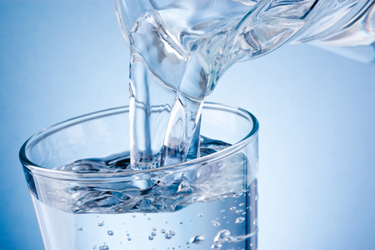Water Quality Is Not A Guarantee
By Les Merrill

We often take our drinking water for granted. We always have access to running water, so we don't think much more about it. However, quality water is not always a guarantee. In fact, a number of cities are having issues with their water right now. The government creates laws to protect drinking water, and the EPA determines guidelines for how to ensure safe drinking water. Unfortunately, water quality issues may still arise that put you and your family at risk for disease — or worse. Let me share some of the most serious risks to your drinking water and how to solve them.
Corrosion
Corrosion occurs when the metal surface of the pipe breaks down. This exposure may introduce contamination into your drinking water that could cause health issues.
There are two main types of corrosion: microbial and chemical. Microbial corrosion occurs when a biological material forms a film that reacts with the piping in your home. Chemical corrosion occurs when the water chemistry becomes unbalanced. For instance, simple changes in water pH levels (or many other factors) can cause pipe deterioration. In addition to harmful chemical and microbial exposure (which we discuss in the next section), contaminations can lead to a number of waterborne illnesses including:
- Legionnaire’s Disease. Legionnaire’s is usually spread from airborne droplets of bacteria-contaminated water from pools, fountains, or home tap water. While it is rarely spread to other people, and can be treated with antibiotics, Legionnaire’s is a serious illness that impacts your lungs and can cause headaches, shortness of breath, fever, and muscle aches.
- E. coli. Exposure to the bacteria E. coli (coliform) can lead to serious side effects including diarrhea, vomiting and stomach cramps. Young children and the elderly often experience more extreme effects and can be at risk of kidney failure. While rare, E. coli can get in your plumbing system if the water source gets contaminated. When this happens, your city will put out a boil order to purify the water.
- Typhoid fever and cholera. Among other waterborne diseases, typhoid and cholera are serious bacterial infections that can be fatal.
Lead
While we now know that no amount of lead in water is safe, that was not always common knowledge. Up until the 1980s, lead was used in pipes, paint, and a number of items around the house. Once the risks of lead were discovered, most cities and homeowners did what they could to replace any lead pipes as quickly as possible. However, what many people do not realize is copper plumbing pipes were connected using lead-based solder. Lead can also creep in from brass fittings and galvanized pipe. The source of lead is not always easy to trace, but certain water tests can help you determine if there are traces of lead in your drinking water.
A handful of high-profile stories are in the news about lead contamination in cities across the country, with Flint, Michigan being the most notorious case. The dangers from lead poisoning are substantial- violence, cognitive delays, headaches, stomach issues, and joint issues are the most common symptoms. A recently released study shows there can be irreversible damage done when infants and children are exposed to lead, so vigilance about monitoring lead levels from any source is crucial. Certain water tests can help you determine if there are traces of lead in your drinking water to help you avoid lead contamination.
Copper
One source of copper poisoning is the corrosion of copper pipes. Symptoms of copper poisoning can include headaches, fevers, throwing up, and jaundice.
Copper poisoning may happen when an unsuspecting homeowner installs a “treatment option” purchased at a big box store or online that promises it is the BEST filtration system. Depending on the chemistry of the water and the chemistry/operation of the new filter, a reaction can take place that leads to high levels of copper being introduced into the drinking water.
The nice thing about copper is that it can be visible to the eye, if you know what to look for. In high doses, copper turns the water a blue or greenish tint.
Plastic-Related Chemicals
Recently, the amount of plastics in our bodies and drinking water has been in the news. Per- and polyfluoroalkyl substances (PFAS) from plastic containers, non-stick pans, etc. all put you at increased risk. These harmful chemicals can lead to cancer, issues with oxygen absorption, infertility, and more.
Microplastics are such a major part of our lives it is hard to cut them out completely. Because they are so prevalent in our environment, they can get into our drinking water from water runoff, or even from the air. However, you can decrease your exposure and find ways to get it out of your drinking water.
How To Address These Problems
Risks to your drinking water are everywhere, but it is possible to detect issues before it is too late. You can start by checking your contamination levels through testing and treatment to remove the bad stuff and add the good. In some cases, like the risks that come from corrosion, you may choose to replace all the pipes in your home. In other cases, you may opt for a water filtration and conditioning system to ensure correct water pH and to take out any elements or chemicals that could have seeped into your water.
In the United States, we take quality drinking water for granted, but it is important to do our part to ensure the water we are drinking is safe.
 Les Merrill currently serves as President for RETEGO Labs, LLC, where he leads all efforts for product and business development, manufacturing, and strategic relationships. His 40 years of experience in manufacturing, international project management, and sales to the water and wastewater industries have given Les a unique insight into water challenges around the world. He holds several U.S. and international patents relating to the treatment of complex industrial wastewaters and other patent applications relating to water treatment. Les currently serves on the Advisory Council for the International Water Conference and is an active member of the Water Quality Association, Pacific Water Quality Association, and Eastern Water Quality Association.
Les Merrill currently serves as President for RETEGO Labs, LLC, where he leads all efforts for product and business development, manufacturing, and strategic relationships. His 40 years of experience in manufacturing, international project management, and sales to the water and wastewater industries have given Les a unique insight into water challenges around the world. He holds several U.S. and international patents relating to the treatment of complex industrial wastewaters and other patent applications relating to water treatment. Les currently serves on the Advisory Council for the International Water Conference and is an active member of the Water Quality Association, Pacific Water Quality Association, and Eastern Water Quality Association.
